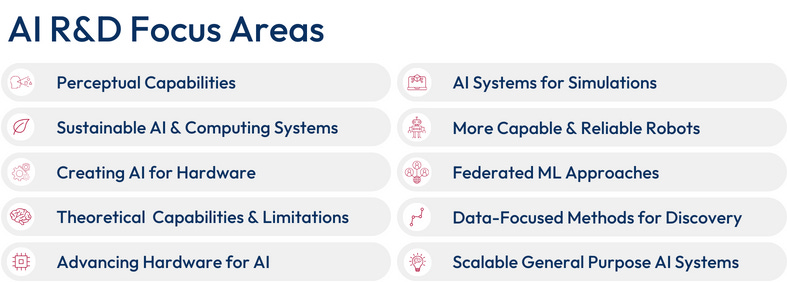The Innovation Imperative: Ramping up Federal R&D Spending
Hello, I’m Ylli Bajraktari, CEO of the Special Competitive Studies Project. In this edition of 2-2-2, SCSP’s Nyah Stewart, Associate Director for Future Technology Platforms, provides an overview of SCSP’s recent white paper, Funding For the Future: The Case for Federal R&D Spending.
Please join us on May 7-8, for the AI Expo for National Competitiveness, the first of its kind in Washington, D.C., in coordination with the second Ash Carter Exchange on Innovation and National Security.
For more information on how to exhibit, sponsor, or attend visit our website.
Federal dollars fuel innovation power — the ability to invent, adopt, and adapt technologies — by forming the bedrock of American innovation. As the world enters a new era where artificial intelligence converges with other fields and rapidly accelerates technological change, federal funding for R&D is critical. Government spending spurs scientific breakthroughs and the development of general-purpose technologies, like the Internet. Federal investments can also jumpstart forms of new economic growth, encourage R&D funding from non-federal sources, and signal national priority areas, such as testing and evaluating AI models or developing mRNA vaccines. Additionally, and most importantly, federal funding for R&D provides long-term investments into areas in the public good and the nation's interests, galvanizing the research and development that will translate into technological competitiveness.

However, the current status of federal research and development (R&D) funding in the United States may be insufficient to support America’s innovation ecosystem. Over the past six decades, the share of R&D funded by the federal government has steadily declined. Historic legislation to bolster American innovation, like the CHIPS and Science Act, remains underfunded. The White House has sent important policy signals through its AI Executive Order, like the recent piloting of the National AI Research Resource (NAIRR), but these initiatives need additional resourcing. The United States is in a technological competition where innovation power determines global leadership, and it can not afford more delays, decreases, or cuts to federal R&D spending as the People's Republic of China rapidly bolsters spending for science and tech. Now is the time for the United States to expand government investments in research and development.

SCSP’s newly released white paper, Funding For the Future: The Case for Federal R&D Spending, provides an initial assessment of the federal R&D landscape and lays out recommendations for consideration and discussion. The top line recommendations are below, suggesting how the United States should bolster its investments in the American innovation ecosystem. Specifically, the United States should increase overall federal R&D spending, boost funding for AI R&D, and explore ways to improve the federal funding process.
Increase Overall Federal R&D Funding to One Percent of GDP by 2030.
At one percent of the nation's gross domestic product, the government would spend $353.4 billion on research and development, funneling massive amounts of investment into science and technology to spur innovation. To push the nation forward and towards this funding goal, the United States should fully appropriate the authorized funding levels outlined in the CHIPS and Science Act, which aims to bolster America's R&D enterprise but remains underfunded today.
Expand Non-Defense AI R&D Funding to Reach $32 Billion in Fiscal Year 2026.
To harness artificial intelligence's ability to advance innovation, the National Security Commission on AI proposed that federal spending for non-defense AI R&D reach $32 billion by Fiscal Year 2026. To reach this goal, federal funding for non-defense AI R&D should increase to $8 billion and double annually over the next three fiscal years. An increase in federal investment should support basic and applied AI research, continue to encourage the AI field to evolve by directing resources to create and enhance critical R&D infrastructure, and fund exploratory programs that develop AI applications, like an "S&T Discovery Platform." Overall, increased funding for non-defense AI R&D would foster innovation by allowing various actors to contribute to the field and provide a demand for R&D in the nation's interest, like the testing and evaluation of frontier models.

Continue to Explore Ways to Improve the Federal Funding Process.
Increased federal funding for R&D alone will not translate into national technology leadership. The United States must revitalize the federal funding process to fully take advantage of this new, fast-paced era of scientific discovery and tech development. Modeling some federal funding mechanisms after the National Science Foundation's RAPID (Rapid Response Research) and EAGER (Early-concept Grants for Exploratory Research) programs could get government dollars into researchers' hands quicker, propelling scientific and technological advancement. Switching to a milestone-based awards system would create more sustained investments for R&D that require incremental progress, like delivering fusion energy plants to the grid. Other changes to the federal funding process could offer flexible and risk-tolerant mechanisms to invest in unexpected breakthroughs or encourage the movement of R&D projects from a theoretical idea into a technical reality. By tweaking the federal funding process, increased federal R&D funding would have a greater impact on America's innovation ecosystem.
Boosting the federal R&D budget would not only stimulate economic growth but also fortify national security and strengthen U.S. technological leadership in a rapidly evolving landscape driven by the convergence of AI and strategic industrial sectors. Federal funding must dare to place larger bets to fuel this next generation of research and development, all while enhancing agility to swiftly allocate resources toward unforeseen breakthroughs on the horizon. Increased federal investments in R&D should also be strategic and coordinated to encourage interdisciplinary collaboration between federal departments and agencies, research institutions, and industry stakeholders. Finally, it is imperative that federal funding offers the nation a long-term vision of R&D priorities insulated from the political budget cycle. By abiding by these principles, the United States will be able to ensure that neither budgetary delays nor budget reductions hamper the nation’s ability to adopt and adapt to the technologies of today but also invent and shape those of tomorrow.







